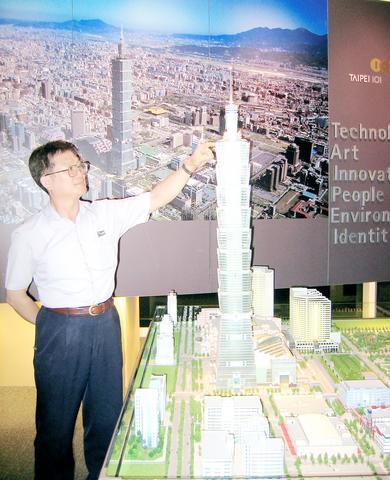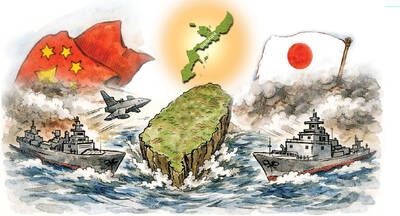Ask anybody in Taiwan where the world's tallest building is and you'll be met with an unashamedly huge grin followed by an exuberant, "Taipei!"
Ask the same person about the world's fastest elevator and chances are that national pride will quickly dissipate and be replaced by a bemused and forlorn look of despair as they search for an appropriate sounding answer.

PHOTO: GAVIN PHIPPS, TAIPEI TIMES
The Taipei 101 building itself may have received worldwide attention ever since the 101-story, 508m-tall edifice was officially crowned "the world's tallest building," after the placing of the 60m spire on Oct. 17 last year. Yet, the fact that the behemoth building also boasts the world's fastest elevator system has been little but a footnote in 101 related narratives.
Set to carry sightseers to the 388m high, 89th floor indoor observation deck, the two observation deck elevators will reach top speeds of 1,010 meters per minute, or 60kph, on their ascent and top speeds of 600 meters per minute, or 36kph on their descent. In comparison, a passenger aircraft's climb and descent rates average no more than 308 meters per minute, or 18kph.
The elevators will reach their full potential speeds for a mere six seconds in either direction and visitors hoping for a long ride will be sorely disappointed. In-elevator time will total 39 seconds going up, and 46-seconds coming down.
Developed by US based elevator consultants Lerch, Bates and Associates and jointly manufactured by Toshiba Japan and GFC Taiwan (崇友實業股份有限公司), it has taken nearly four years bring the two specially built observatory elevators from the drawing board to the current test stage. Each elevator weighs in at 1,600kg and is large enough to carry 24 people.
According to Cathy Yang (楊文琪), Assistant Vice President of the Taipei Financial Center Corp. (台北金融大樓股份有限公司), the elevator will go to the top and down again in three-and-a-half minutes.
Manufacturing costs have totaled roughly NT$100million per elevator, which is almost double that of Toshiba/GFC's previous venture -- the once cutting edge NT$60 million observatory elevator in Taipei's Shin Kong Life Insurance Building.
"I can't see anybody manufacturing a faster elevator system for at least the next five or six years," said GFC's Lin Ming-hui (林明輝). "It's not a question of technology, as we've proven that, but it's a question of capital. To develop, install and maintain a faster elevator system than ours would cost a [terrifying] amount of money."
Prior to the installation of the 101's observation deck elevators the 85-story, 348m Kaohsiung T and C Tower has held the record for the nation's fastest elevators, with a time of 600 meters per minute since 1997. And the world's fastest elevators belonged to that of Japan's 70-story, 296m high Yokohama Landmark Tower. At a mere 766 meters per minute, however, the once world record-breaking elevator system has now been outpaced by a staggering 243 meters per minute.
Taipei's two other skyline-hogging skyscrapers, the 51-story, 244m tall Shin Kong Life Insurance Building and the 43-story, 169m tall Far Eastern Plaza Hotel and Far Eastern Textiles Tower may look like contenders, but with speeds of only 540 meters per minute and 360 meters per minute respectively, are small fries indeed when compared to the Taipei 101.
Of course, manufacturing these record-breaking elevators was no easy task. While designers can create elevators that reach staggering speeds and climb to great heights, ensuring passenger comfort is another matter entirely.
"Sure, we can make fast elevators, but the problems arise when trying to make them comfortable for human travel," said Lin. "Ensuring the safety and comfort of passengers means that we have had to create plenty of state-of-the-art equipment, all of which has had to undergo extensive testing."
Mounting air pressure inside the elevator capsules was one of the designers' biggest problems. As in an aircraft, if pressure increases or decreases too rapidly passengers can pass out and/or rupture their eardrums. To counter this each elevator is hermetically sealed and a huge twin air-pressure control system, which is mounted on top, begins resetting cabin pressures as soon as the doors close.
Noise abatement was also a crucial element in the design process. In order to suppress noise in both the building and the elevators themselves, the two airtight observation deck elevators have been aerodynamically shaped to resemble bullets. This shape allows for a massive reduction of aerodynamic drag, or windage, which cuts down any unwanted noise creating drag.
"Obviously, as the 101 was an office building we had to pay close attention to amount of noise the elevators could make," Lin said. "We spent a lot time working on this, but have come up with solutions that make the elevators soundproof and almost sound-less."
Duel structured walls, sound isolation shrouds, acoustic tiles, the addition of isolated floor platforms and the wrapping of the counterweights in aerodynamic sheets means that the noise level both inside and outside the elevators is no greater than 45 decibels. This is a noise level that, according to the US environmental protection agency, has been "identified as preventing activity interference and annoyance."
In the event of an earthquake, passengers need not panic as the elevators are connected to the 800 tonne steel sphere wind-damper, via the building's mainframe computer system. Located on the 88th floor, the huge steel pendulum automatically counteracts any movement the building may undergo.
Should high winds or a strong earthquake cause the steel sphere to move more than 15cm the elevators' state of the art braking system, which when applied, gives the elevators a stopping distance of 40m, kicks in. The high-wind emergency operation ensures the elevators either reduce speed or cease operation automatically and allow passengers to alight depending on the building's sway.
With top operational speeds of over 1,000 meters per minute, conventional bronze elevator safety shoes would simply melt, so designers have instead turned to NASA for inspiration. Like the space shuttle's braking system, the 101's elevators employ specially designed and costly silicon nitride ceramic braking shoes. The cost and the origin of which are, according to Lin, a closely guarded secret.
The technology used to ensure the elevator's stability makes it one of the smoothest elevator rides in the world. A NT$50 coin can be placed on its rim on the floor of the elevators and it will not topple over during the ascent or descent.
According to Lin, the extensive testing programs that are currently underway will be completed some time in early October.
The elevators will not be open to the general public until the end of the year. Engineers like Lin, however, are eagerly waiting for the moment when they can try out the world's fastest elevators for the first time.
"Of course I'm looking forward to going in them," Lin said. "It's been nearly four years since we began developing them and I reckon we've waited long enough."
As for who will be the first non-company related individual to ride in Taiwan's record-breaking elevators, well, that honor is being kept for President Chen Shui-bian (陳水扁) when he participates in the building's grand opening in late December.
Taipei 101
101 stories; 508m in height
Top speed 1,010 meters per minute (60kph)
T and C Tower:
85 stories; 348 meters in height
Top speed 600 meters per minute (36kph)
Shin Kong Life Insurance Building
51 stories; 244m in height
Top speed 540 meters per minute (32kph)
Far Eastern Plaza Hotel and Far Eastern Textiles Tower
43 stories; 169m in height
Top speed 360 meters per minute (21kph)

Most heroes are remembered for the battles they fought. Taiwan’s Black Bat Squadron is remembered for flying into Chinese airspace 838 times between 1953 and 1967, and for the 148 men whose sacrifice bought the intelligence that kept Taiwan secure. Two-thirds of the squadron died carrying out missions most people wouldn’t learn about for another 40 years. The squadron lost 15 aircraft and 148 crew members over those 14 years, making it the deadliest unit in Taiwan’s military history by casualty rate. They flew at night, often at low altitudes, straight into some of the most heavily defended airspace in Asia.

Beijing’s ironic, abusive tantrums aimed at Japan since Japanese Prime Minister Sanae Takaichi publicly stated that a Taiwan contingency would be an existential crisis for Japan, have revealed for all the world to see that the People’s Republic of China (PRC) lusts after Okinawa. We all owe Takaichi a debt of thanks for getting the PRC to make that public. The PRC and its netizens, taking their cue from the Chinese Communist Party (CCP), are presenting Okinawa by mirroring the claims about Taiwan. Official PRC propaganda organs began to wax lyrical about Okinawa’s “unsettled status” beginning last month. A Global

Taiwan’s democracy is at risk. Be very alarmed. This is not a drill. The current constitutional crisis progressed slowly, then suddenly. Political tensions, partisan hostility and emotions are all running high right when cool heads and calm negotiation are most needed. Oxford defines brinkmanship as: “The art or practice of pursuing a dangerous policy to the limits of safety before stopping, especially in politics.” It says the term comes from a quote from a 1956 Cold War interview with then-American Secretary of State John Foster Dulles, when he said: ‘The ability to get to the verge without getting into the war is

Like much in the world today, theater has experienced major disruptions over the six years since COVID-19. The pandemic, the war in Ukraine and social media have created a new normal of geopolitical and information uncertainty, and the performing arts are not immune to these effects. “Ten years ago people wanted to come to the theater to engage with important issues, but now the Internet allows them to engage with those issues powerfully and immediately,” said Faith Tan, programming director of the Esplanade in Singapore, speaking last week in Japan. “One reaction to unpredictability has been a renewed emphasis on